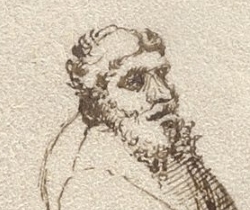|
|
You are not currently logged in. Are you accessing the unsecure (http) portal? Click here to switch to the secure portal. |
Wiktenauer:Main page/Featured
| Fiore Furlano de’i Liberi | |
|---|---|
 This master with a forked beard appears sporadically throughout both the Getty and Pisani Dossi mss., and may be a representation of Fiore himself. | |
| Born | 1340s Cividale del Friuli, Friuli |
| Died | after 1420 France (?) |
| Relative(s) | Benedetto de’i Liberi |
| Occupation |
|
| Nationality | Friulian |
| Patron |
|
| Influences | |
| Influenced | Philippo di Vadi |
| Genres | |
| Language | |
| Notable work(s) | The Flower of Battle |
| Manuscript(s) |
MS M.383 (1400s)
|
| Concordance by | Michael Chidester |
Fiore Furlano de’i Liberi de Cividale d’Austria (Fiore delli Liberi, Fiore Furlano, Fiore de Cividale d’Austria; ca. 1340s - 1420s) was a late 14th century knight, diplomat, and itinerant fencing master. He was born in Cividale del Friuli, a town in the Patriarchal State of Aquileia (in the Friuli region of modern-day Italy), the son of Benedetto and scion of a Liberi house of Premariacco. The term Liberi, while potentially merely a surname, more probably indicates that his family had Imperial immediacy (Reichsunmittelbarkeit), either as part of the nobili liberi (Edelfrei, "free nobles"), the Germanic unindentured knightly class which formed the lower tier of nobility in the Middle Ages, or possibly of the rising class of Imperial Free Knights. It has been suggested by various historians that Fiore and Benedetto were descended from Cristallo dei Liberi of Premariacco, who was granted immediacy in 1110 by Holy Roman Emperor Heinrich V, but this has yet to be proven.
Fiore wrote that he had a natural inclination to the martial arts and began training at a young age, ultimately studying with “countless” masters from both Italic and Germanic lands. He had ample opportunity to interact with both, being born in the Holy Roman Empire and later traveling widely in the northern Italian states. Unfortunately, not all of these encounters were friendly: Fiore wrote of meeting many “false” or unworthy masters in his travels, most of whom lacked even the limited skill he'd expect in a good student. He further mentions that on five separate occasions he was forced to fight duels for his honor against certain of these masters who he described as envious because he refused to teach them his art; the duels were all fought with sharp swords, unarmored except for gambesons and chamois gloves, and he won each without injury.
Writing very little on his own career as a commander and master at arms, Fiore laid out his credentials for his readers in other ways. He stated that foremost among the masters who trained him was one Johane dicto Suueno, who he notes was a disciple of Nicholai de Toblem; unfortunately, both names are given in Latin so there is little we can conclude about them other than that they were probably among the Italians and Germans he alludes to, and that one or both were well known in Fiore's time. He further offered an extensive list of the famous condottieri that he trained, including Piero Paolo del Verde (Peter von Grünen), Niccolo Unricilino (Nikolo von Urslingen), Galeazzo Cattaneo dei Grumelli (Galeazzo Gonzaga da Mantova), Lancillotto Beccaria di Pavia, Giovannino da Baggio di Milano, and Azzone di Castelbarco, and also highlights some of their martial exploits.
(Read more...)
- Recently Featured:
- Sigmund Schining ain Ringeck – Joachim Meÿer – Paulus Hector Mair – Die Blume des Kampfes
